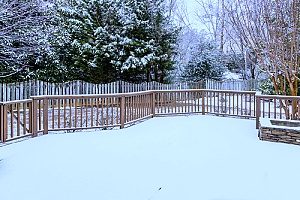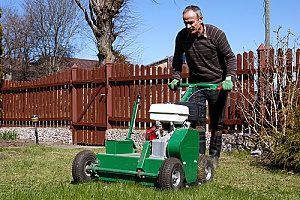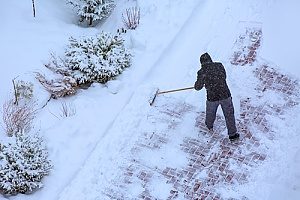 As the weather gets colder, it’s important that you follow a few necessary steps to preserve your lawn over the winter months so you can keep your yard clean, well maintained, and in good condition to begin landscaping projects in the spring and summer. Some require moderate effort, like aerating and fertilizing your lawn, while others are more simple, such as making sure that leaves and sticks don’t pile up. Performing simple winter lawn care will ensure that when the temperature starts to get warmer again as you start preparing for your upcoming landscaping projects, you’ll know that your lawn, as well as the fill dirt supporting it, are in good condition.
As the weather gets colder, it’s important that you follow a few necessary steps to preserve your lawn over the winter months so you can keep your yard clean, well maintained, and in good condition to begin landscaping projects in the spring and summer. Some require moderate effort, like aerating and fertilizing your lawn, while others are more simple, such as making sure that leaves and sticks don’t pile up. Performing simple winter lawn care will ensure that when the temperature starts to get warmer again as you start preparing for your upcoming landscaping projects, you’ll know that your lawn, as well as the fill dirt supporting it, are in good condition.
Whether you’re going to be installing an inground pool, building a deck, a backyard shed, or simply creating a garden, a well-maintained yard will make it much easier for you to work with fill dirt and topsoil. Keeping your yard in good shape throughout the winter means that you’ll have less work to do when the springtime rolls around.
Here are the top 5 lawn care tips for preparing your yard in the winter for springtime yard projects:
1. Fertilize
Everybody wants a thick, lush lawn, but in order to make this a reality, you’re going to have to take special care of your lawn during the winter. It’s recommended that you fertilize your lawn about four times a year, but many people neglect the winter season because they assume it’s not helping their lawn at all. Many homeowners overlook the fact that their lawn is actually in need of the nutrients that fertilizer can provide during the winter months. Your grassroots will be able to absorb these nutrients, which will give them a head start growing when springtime rolls around. Fertilizing is one the best ways to have a well-kept lawn. A well-kept lawn during the winter will also help prevent weeds, pests, and diseases from moving in when the temperature starts to increase.
You’ll want to apply your fertilizer with a spreader. To spread the fertilizer, you’ll move the spreader in a back and forth motion while dispersing the fertilizer pellets. Make sure to never spread the product by hand, and always use a lawn spreader. It’s very important that you only lay the recommended amount, as too much fertilizer can actually burn your grass.
2. Aerate
 Right before you are expecting your first frost, head out to your lawn and aerate. Aeration is an important process to help your grassroots get some extra air. This is done by perforating the soil with small holes so water, air, and nutrients can reach your grassroots easier. This process is very important right before the winter starts because it will help the roots grow deeper and will aid in producing a strong lawn. Another main reason for aerating your lawn is to alleviate soil compaction. A compacted lawn can have built up solid particles that prevent proper circulation of air, water, and nutrients in the soil. Excess lawn thatch or heavy organic debris can become buried under the grass surface and begin to starve your grassroots. Aeration will help to diminish this.
Right before you are expecting your first frost, head out to your lawn and aerate. Aeration is an important process to help your grassroots get some extra air. This is done by perforating the soil with small holes so water, air, and nutrients can reach your grassroots easier. This process is very important right before the winter starts because it will help the roots grow deeper and will aid in producing a strong lawn. Another main reason for aerating your lawn is to alleviate soil compaction. A compacted lawn can have built up solid particles that prevent proper circulation of air, water, and nutrients in the soil. Excess lawn thatch or heavy organic debris can become buried under the grass surface and begin to starve your grassroots. Aeration will help to diminish this.
Make sure you’re aerating your lawn when the soil is moist enough, doing it when the soil is dry will just make it more challenging for yourself. Use your aeration machine to pass over the parts of your lawn that need it. Most of these machines can only cover a small percentage of the soil surface, so it’s important that in the most compacted areas you go over it multiple times. This process can be extremely beneficial to your lawn, and make all the difference in the spring when you want to start your fill dirt and landscaping project.
3. Keep Your Lawn Clean
While this sounds like a super simple step, it’s importance should not be overlooked. Keeping your lawn clear of leaves is especially important because if enough of them build up, you could be suffocating your grass before winter even begins. Wet leaves can also become an invitation to disease. If your leaves are dry and thin, you can simply run them over with your lawn mower to break them up into much smaller pieces. This is great because it will recycle the nutrients back into your yard. Unfortunately, if the leaves are wet and thick, you’ll need to rake them and remove them. It’s also a good idea to regularly take care of the leaves in your yard, rather than waiting towards the end of fall when they’ve all piled up. If you wait till then, the damage to your grass may already be done.
Also remove any large debris, logs, lawn furniture, or toys that are out on the lawn. Over the winter time, these objects can smother your grass, create disease conditions, and invite pests like mice or insects.
4. Clear Away Ice
 Throughout the entirety of the winter, you should make sure that your driveways, walkways, and sidewalks are clear of ice and snow as they can present serious safety hazards. If you know a winter-freeze or big storm is coming, it’s a good idea to chip away a little-exposed ice in low spots. Your yard is more resilient than you think and will be able to survive heavy snowfall, but ice always presents a tricky hazard.
Throughout the entirety of the winter, you should make sure that your driveways, walkways, and sidewalks are clear of ice and snow as they can present serious safety hazards. If you know a winter-freeze or big storm is coming, it’s a good idea to chip away a little-exposed ice in low spots. Your yard is more resilient than you think and will be able to survive heavy snowfall, but ice always presents a tricky hazard.
5. Reduce Foot Traffic
During the winter months when your grass is dormant, it’s best that you limit the amount of damage you cause when walking on top of it. This is an easy and simple step and just means that you should probably take the long way to your front door rather than cutting through your yard. It really will make a difference in the health and quality of your grass when springtime rolls around. If you develop a heavily worn path during the winter, you’ll notice that this area of your yard takes much longer to turn green in the spring.
Don’t park any cars or trucks on your lawn during the winter. Even the smallest car will leave behind impressions in the soil and the grass that is underneath the tires will die. This area will also be more at risk for crabgrass and weeds.
Speak to a Virginia Fill Dirt Contractor
Whether you are planning on completing a yard project yourself this spring, or are in search of assistance in making sure it’s professional quality, reach out to a Virginia fill dirt contractor. They can provide you with more information about lawn care tips for the winter months, along with a free fill dirt or topsoil delivery for a host of residential yard work projects.









































